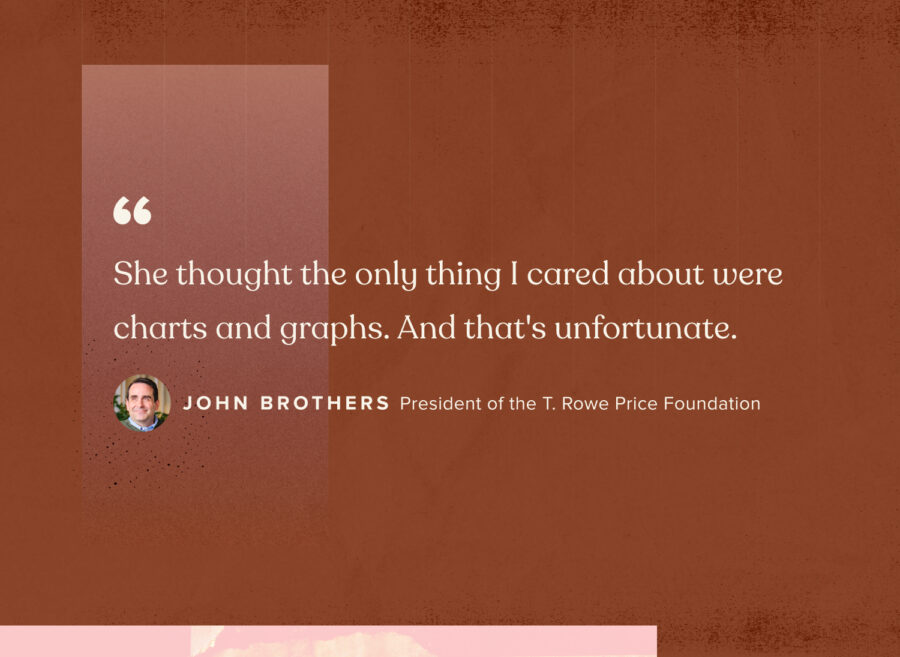Balancing the inherent power imbalances of nonprofit corporate partnerships often feels like walking a tightrope. Nonprofits need funding and know their community well, while corporations have funding but lack that deep understanding of the community.
In this tension is potential. And the key to unlocking it often lies in understanding where the most impactful ideas in philanthropy originate—the communities themselves.
Devi Thomas, Global Leader of Nonprofit Community Capacity at Microsoft Philanthropies, has spent decades in the nonprofit sector developing community relationships. In her perspective, corporations shouldn’t be just funders, but instead active participants in a dialogue that respects and uplifts community voices.
This approach to nonprofit fundraising ideas can bridge the gap between resource availability and impactful action, leading to sustainable change.
As we explore the depths of these nonprofit corporate partnerships, we’ll explore how aligning corporate resources with grassroots initiatives and community-led ideas can forge a path for transformative social impact.

Typical nonprofit corporate partnerships are unbalanced
Unlike traditional business partnerships, nonprofits and corporations don’t typically interact on a level playing field. Companies hold funding and resources, while nonprofits seek a slice of that pie for their communities. There’s often immense pressure on nonprofits to prove the impact of their work, to show they’re using their grantor’s money well.
John Brothers recalls that, as he was starting his role as the President of the T. Rowe Price Foundation, a well-known nonprofit leader walked into his conference room prepared with the numbers.
“Before I could even really know her name, she pulled out all these charts and graphs, and she started to show me why she was valuable,” said Brothers. “And it was just so backwards. I didn’t get a chance to know about her. I didn’t get a chance to see what she felt was important and what was the North Star for her organization… She thought the only thing I cared about were charts and graphs. And that’s unfortunate.”

Brothers points to this anecdote as an indicator of the historically unbalanced power dynamic in nonprofit corporate partnerships–not just at the T. Rowe Price Foundation, but across the industry.
Nonprofits and companies should have honest dialogues about how to help each other and get to know each other as people, instead of focusing on crunching numbers and looking for value-add from the start. By doing so, corporate philanthropy can benefit both parties equally and level the playing field a bit more.
Better partnerships stem from mutual respect and understanding
Due to the power they wield, corporations need to step up and redefine their relationships with grantees, moving from a one-way transactional relationship to a two-way dialogue based on empathy and learning.
Defer to those closest to local communities
Because they’re disbursing the funds, funders can often appear like they know best. This power can be intoxicating, but, if you’re a funder, you need to keep in mind that there’s much you don’t know.
“A lot of the time, there is a sense when a corporation is sitting at a table with a nonprofit, that that corporation might have the answer to everything,” says Devi Thomas. “But the reality is—and I know this from my time in the nonprofit sector—that the more proximate you are to the problems, you have a much better view of exactly what’s needed to help local communities. And that those solutions are coming from the local communities themselves.”
What Thomas says aligns with what we know about grassroots-led initiatives, which are proven to lead to more sustainable social impact. That’s because those closest to the communities you’re serving are more aligned with their needs and better equipped to effect change in ways that stick. Instead of a top-down approach, start by listening to those on the ground: You’ll get farther, faster.
Treat grantmaking as “house calls” instead of business deals
When you visit someone’s home, you follow their house rules—taking your shoes off, if asked, for instance. Similarly, companies should act as visitors when dealing with nonprofits, seeking to understand and appreciate the host’s world, rather than dictate how they should act.
“If I walked into your home, and said, hey step on the scale and you should weigh what I think you should weigh,’ you’d tell me to get the heck out of your house—as you should,” says Brothers.
Grantmaking should be about building a connection based on mutual respect, open dialogue, and a shared commitment to meaningful impact. Brothers continues: “When we have the good fortune of being able to step into a local community, which we really regard as we are walking into somebody’s home, we hold that ground sacred.”
Corporate grantors aren’t the bosses of nonprofit grantees. It’s not up to corporate partners to determine what success should look like; that responsibility and ownership belong to the communities they serve. Corporations are simply there to support nonprofits in doing the work necessary to get to those outcomes.
Take a trust-based approach to philanthropy
As the name implies, trust-based philanthropy is a movement centered on building trust in relationships between funders and grantees. It’s a critical shift in the fundamentally imbalanced power structure of grantmaking, sharing control of decision-making and resource allocation.
“We are trying to knock down barriers. We are trying to take away the power dynamic so that we can be in an eye-to-eye conversation about how to be valuable members in their community,” said Brothers. “And you can’t do that if there’s a power dynamic that both companies or philanthropy set up in their advantage, and then misuse.”
We’ve written quite a bit about trust-based practices (Submittable is using it now), but your best source to learn more is the Trust-Based Philanthropy Project. They have six practices and five values you can follow, along with examples. We also recommend reading this interview with Pia Infante on its origins.
By embracing these approaches established by the Trust-Based Philanthropy Project, corporations can reinvent themselves from mere funders to true partners in social impact.

What you can do as a funder
Corporations hold a substantial amount of power in nonprofit corporate partnerships, often determining how goals are set and how success is measured. However, it’s up to funders to flip this script.
By rethinking traditional roles and approaches, corporations can transform these power imbalances into opportunities for equitable, collaborative partnerships.
Actively listen to and learn from grantees
Listening to your communities in an active, engaged process. There’s much they have to say, and if you don’t make space for them to say it, you won’t be able to apply a truly collaborative stance to your corporate philanthropy.
Thomas explains Microsoft’s approach to community-centric philanthropy: “Our best contribution as a company comes from learning from others, and from sharing those learnings, and being part of a community that can solve problems together.”
This is a shift from a top-down, solution-imposing method to an empathetic, learning-oriented model.
“We believe that no one company, industry, or country can really solve some of the most complex problems alone,” says Thomas. “So we like to build that bridge across sectors and borders, and foster that collective action to drive progress so much faster than we can do on our own.”
For Microsoft Philanthropies, listening translates into empowering over 300,000 nonprofits and community changemakers, understanding their unique situations, and empowering them to drive the impact they envision. Microsoft serves as a facilitator in this context, equipping NGOs and communities with the necessary tools—whether in the form of technology, policy support, or skill development—to make strides towards systemic change.
Successful nonprofit corporate partnerships come from understanding grantees’ realities from their perspective, respecting their knowledge and expertise, and committing to mutual learning and shared goals. More than just providing resources, your mission should be to create a collaborative space where genuine understanding leads to transformative, sustainable change.
By taking these steps to create an open dialogue with your partners, you’ll be in a far better position to strengthen your CSR program.
Offer long-term, flexible financial support
When you invest in a brand, you’re not investing in a product. As Brothers likes to put it, you don’t invest in just Diet Coke, you invest in Coca-Cola. Similarly, funders shouldn’t invest in nonprofits for a one-off engagement or program, but instead, commit to multi-year funding.
“We would never invest in only a product of a company. We would invest in the company. And we would hope they would have great products,” says Brothers.
Making a long-term commitment demonstrates trust in the nonprofits’ management of grant funds, and allows grantees to focus on their mission without constant financial uncertainty.
Equally important is the nature of the funding. Flexible, unrestricted funding empowers nonprofits to allocate resources where they are most needed, rather than being confined to rigid guidelines or specific project scopes dictated by funders.
This type of funding recognizes that those working on the ground are best positioned to understand and respond to the challenges and opportunities they face. It also gives nonprofits the freedom to experiment and iterate in response to adaptive needs, something they otherwise wouldn’t be able to do, given the nature of incremental fundraising.
Focus on impact over numbers
Traditional CSR metrics often emphasize numbers as markers of success. However, a more meaningful approach involves evaluating the depth and sustainability of the impact created by these CSR initiatives.
Jaimie Vargas, Head of Global Social Impact at Electronic Arts, says corporations need to be willing to see less on paper in order to see more of an impact in the community.
“We have to be willing to take some risks, try some things out and pilot and test that may not work, and be willing to accept that there may be fewer line items on the spreadsheet, but the end result may be more transformational and actually move the needle further in that larger outcome of what we want to achieve in the community,” says Vargas.
Monitor long-term impact over short-term numbers. For example, instead of hours volunteered or donations collected, look instead at employee participation rates for your corporate volunteerism and corporate giving programs, and the qualitative stories that come from those events. Those can be a greater indicator of how well your programs actually resonate with your workforce and your communities.
By adopting this approach, corporations can ensure that their support contributes to meaningful change, rather than simply fulfilling socially empty CSR quotas.

What you can do as a nonprofit
As a nonprofit, approach grantmaking as more than just securing funds. It’s about building sustainable, mutually beneficial relationships with partners that align with your mission and values.
Advocate for your community’s needs
Nonprofits should be subject matter experts in their communities, and able to articulate what their communities need most. Clearly communicate your organization’s goals, challenges, and the specific support you require from sponsors—and why that form of support, whether funding, resources, expertise, or networking opportunities.
By being upfront about your needs, you set the stage for a partnership that truly addresses the issues at hand and aligns with your mission.
Seek understanding, not just funding
While financial support is often a critical aspect of corporate partnerships, strive to cultivate relationships that go beyond getting a check. Company grantmakers don’t want to be treated as an ATM. They want to be treated as partners.
Seek a deeper understanding of each other’s values and working methods so that you can work together in alignment towards shared goals. These relationships can yield not just financial support, but also strategic advice, advocacy, and other forms of assistance that are invaluable to your mission.
Demonstrate qualitative impact
In showcasing the impact of your work, focus on the quality of your outcomes rather than just the quantity. Narratives and stories can be powerful in illustrating the real-world impact of your initiatives.
While data and numbers are important, they often don’t capture the full scope of the change you’re driving. Share success stories, testimonials, and case studies that bring your achievements to life. This approach not only resonates more with funders—who are human, too—but also gives a more holistic view of your work’s impact.
Trust-based partnerships are the future of social impact
On both sides of the aisle, it’s clear that more trust in each other is the key to driving long-term, systemic change. For corporate funders, this means reevaluating traditional metrics of success and embracing a more holistic approach to grantmaking that prioritizes deep engagement, long-term support, and active listening. For nonprofits, it’s about advocating for community needs with transparency, seeking genuine understanding, and demonstrating impact in a way that rings true far beyond numbers.
As Thomas remarks, we’re all invested in social good together.
“We are all part of this problem-solving sector. And then, the divides and the lines between public, private, civil, society—everything just starts to blur a little bit. And that is the moment where I think effective partnerships happen,” says Thomas. “Because you’re in that place where you are collaborating for the first time and looking at what everyone can equitably contribute to that conversation, and recognizing that your skill set alone is not enough.”
A good foundation for putting these trust-based practices into action is reliable, yet flexible CSR software. If you’re in the market for CSR software, we created a guide to help you consider your options. You can also get in touch directly by scheduling a demo of our Submittable’s CSR software here.